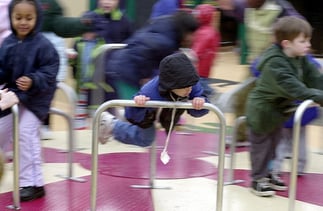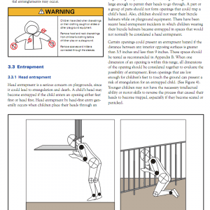Playground Injuries in the News: On a chilly day in California several children were playing on a playground structure. As a 2-year-old began climbing the steps to the slide, the drawstring from his hooded sweatshirt got caught between the slats and stretched tight. In the short time that the childcare employee had stopped watching the playground, the boy lost consciousness. When the boy was seen laying lifeless on the slide the employee rushed to help. CPR was performed on the boy until emergency crews arrived. The boy was pronounced dead at the hospital.
Playground Injury Statistics
An estimated 500,000 children under the age of 14 sustain injuries on playgrounds every year; 100,000 to 200,000 of these injuries require emergency-room care. Although far more children are injured in car accidents than on playgrounds, playground injuries are more likely to be severe.  Severe injuries include broken bones, dislocations, and contusions. On public playgrounds most injuries occur on climbing features, while swings are responsible for most injuries on home/private playgrounds.
Severe injuries include broken bones, dislocations, and contusions. On public playgrounds most injuries occur on climbing features, while swings are responsible for most injuries on home/private playgrounds.
Preventing Playground Injuries
- Make sure surfaces around playground equipment have at least 12 inches of wood chips, mulch, sand, or pea gravel, or safety-tested rubber mats.
- Check that protective surfacing extends at least six feet in all directions from play equipment.
- Make sure structures more than 30 inches tall are spaced at least 9 feet apart.
- Check for dangerous hardware, like open “S” hooks or protruding bolt ends.
- Make sure spaces that could trap children, like guardrail openings or ladder rungs, measure less than 3.5 inches or more than 9 inches.
- Check for sharp points or edges in equipment.
- Look out for tripping hazards, like exposed concrete footings, tree stumps, and rocks.
- Make sure elevated surfaces, like platforms and ramps, have guardrails to prevent falls.
- Check playgrounds regularly to see that equipment and surfacing are in good condition.
- Carefully supervise children on playgrounds to make sure they’re safe.
- Remove drawstrings from a child’s sweatshirt.
Inspecting Playgrounds
Playgrounds receive a tremendous amount of wear and tear. Constant exposure to the elements makes routine inspections, especially before the playground is reopened for the first time each year, so important. The Consumer Product Safety Commission has created an excellent resource for playground safety, which can be downloaded below. In addition, the CPSC created a playground inspection checklist that will allow an individual to make sure any playground is safe for use by children. It’s good practice to use this checklist to inspect your playground every year before letting any children play on it.
Playground Maintenance Handbook
 For answers to all of your questions on playground hazards, design and maintenance take a look at the Public Playground Safety Handbook prepared by the Consumer Product Safety Commission. This 57-page guide is an incredible resource with helpful product descriptions and illustrations. Topics include:
For answers to all of your questions on playground hazards, design and maintenance take a look at the Public Playground Safety Handbook prepared by the Consumer Product Safety Commission. This 57-page guide is an incredible resource with helpful product descriptions and illustrations. Topics include:
- Playground layout considerations
- Pros and cons of typical playground materials
- Proper playground surface depth
- Common crush and shearing points
- Playground testing tools
- Playground checklists




